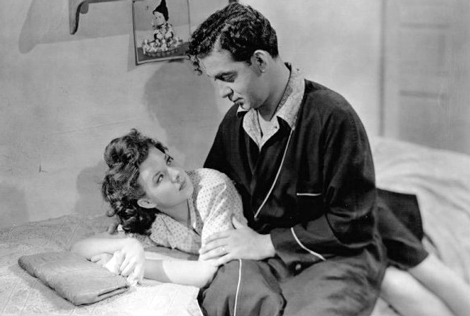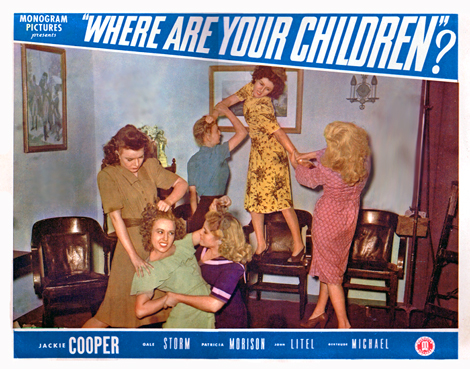Reviewed by Glenn Erickson
America "discovered" teenagers in the 1950s but endured a highly publicized wave of juvenile delinquency ten years earlier, during the war. The rate of middle-class children caught committing adult crimes and partaking of adult vices skyrocketed, providing new challenges for sociologists and reformers. Here was one problem that couldn't be blamed on Nazis or Bolsheviks, or on Bad Kids from the wrong side of the tracks. Fed up with the nightly parade of high school car thieves and sex offenders brought before them, judges refused to cover up for the offspring of well-to-do social folk.
Most '30s movies had either treated youth crime as an aberration, as it was in the short subject series Crime Does Not Pay. But the special conditions of the wartime home front gave America a taste of the future. In towns with war industries, both parents might be employed. A working mom might have kids to care for while her husband held a job in some other part of the country. Previously sleepy factory towns were overrun by new arrivals living in crowded conditions. Their children became latchkey kids, and worse. Babies were left in charge of children not much older. Suddenly living faster lives, parents spent less time at home. Their kids invented their own social life on the streets. Without adult supervision, plenty of America's youth "ran wild".

Juvenile Delinquency was a perfect subject for socially redeeming yet salacious dramas. Producer Val Lewton's record of low-budget success at RKO hit a major snag with his Youth Runs Wild. Apparently too realistic and downbeat for wartime consumption, the film was re-cut by the studio. But disturbing material remains. One scene shows a mother doing nothing while her boyfriend practically molests her daughter. In another, teens stealing tires in a factory parking lot pass a car in which a baby has been left unattended while its parents work their shift. Youth Runs Wild must have met heavy opposition, as it was cut before and after release. The copy that shows periodically on TCM is little more than a butchered remnant.
With the help of writer Hilary Lynn, Monogram producer Jeffrey Bernerd came up with the winning formula. Where Are Your Children? is socially-conscious propaganda that encourages "young people" to be good citizens. Most of the blame is aimed at absentee parents and local governments unwilling to invest in social alternatives to delinquency. The movie did unusually well thanks to a tie-in with a public service campaign by the Hearst Newspaper Syndicate... which in 1943 was unlikely to do the same for a picture from RKO.
Ms. Lynn's story covers all bases. Rich kid Danny Cheston (Jackie Cooper) has enlisted in the Navy, even though his society-minded mother (silent film queen Betty Blythe) would prefer he wait until she can use personal connections to secure for him an officer's commission. Danny drives Jerry and Opal (Jimmy Zahner & Evelyn Eaton) to a dance hall that has sprung up out of nowhere, one that surreptitiously serves liquor to minors. Danny teases and coaxes waitress Judy Wilson (Gale Storm) into dancing with him, but the jealous Opal spikes Judy's drink. Juvenile officer Linda Woodford (Patricia Morrison) insists on taking Judy home. Judy lives with her understanding brother Jim (Anthony Warde) and his hateful, jealous wife Nell (Gertrude Michael) and doesn't even have a room of her own. She falls in love with Danny but he doesn't think they should get serious because he's leaving to join the fleet. Nell accuses Judy of being a "guttersnipe"; and Judy reacts by driving to San Diego with Jerry, Opal and a dangerous kid named Herb (future Sam Fuller fixture Neyle (Marx) Morrow). Angry that Judy won't make out with him, Herb slugs a gas station attendant with a heavy wrench -- and they all become wanted criminals. Meanwhile, Danny has reconsidered everything and decided that Judy's love is important to him after all.

By the standards of 1943 Where Are Your Children? is a smartly assembled entertainment. There's a jitterbug dance scene and a spirited swing vocal of "I'll Be Glad When You're Dead You Rascal You." As was the rule in wartime movies, reassurances are given that the boys going off to war are maintaining high morals. The noble rich kid rejects unearned privileges, and observes sane abstinence, even though he's bound for hazardous duty and leaving behind an irresistible dream girl hopelessly in love with him. What do sailors do on their off duty hours? Danny's Petty Officer (John Laurenz) sings a ballad for the barracks crowd -- "Girl of My Dreams."
This was apparently Jackie Cooper's last picture before leaving to serve in the Navy, which would become the actor's lifelong second career. Like all the other teens, Danny dresses in a suit and tie to leave the house. He has a smooth pickup line for Judy yet respects her completely. Director William Nigh makes a nice "look in any window" moment out of Danny seeing Judy in the diner across the street, dancing to the music from the club. Danny's mom Mrs. Cheston is a hateful snob, who blames all the criminality on "transients" (like Judy) that need to be "put under control."
Gale Storm is a real doll. At 21 years she's a convincing sixteen, and has the perky eyes and chipmunk smile down pat. We feel Judy's shame, living in a shack and working a job where she'll be taken for an "easy to meet" girl. She's equally convincing later on, grim and silent while being grilled by the cops. Naturally, Judy refuses to talk only because she wants to protect Danny. "Everything's closing in on me," she moans. Gale Storm -- film noir femme loser?
The show doesn't let us down in the topical thrills department. Besides the opening jitterbug number, we get some cute courtship scenes. When Judy "goes wild" the fun really starts. Minor actress Evelyn Eaton is a sensation as Opal, the rotten-to-the-core girl who encourages everyone to drink and seems really excited when the car-thief Herb ("He's not afraid of anything, not even the cops!") murders the old busybody at the gas station. Tossed into a room with other juvenile offenders, Opal sizes each of them up with insults and then knocks Judy out cold. That precipitates a really impressive GIRL FIGHT, the kind that would become a must in later Women In Prison pix. Opal is a great example of the 'forties hellcat, smashing a chair in a girl's face as part of her combat. Director William Nigh uses another interesting "look in any window" setup when several reform school girls watch Opal attack a policeman from afar. Should we start looking up William Nigh pictures to document his expressive use of this setup? It's like little slices of Rear Window.
Patricia Morrison's social worker Linda Woodford gets some good scenes telling off the smug, snobbish NIMBYs in the fictional burg of Riverdale. Stopping juvenile crime is important, says Linda. What good is it to win the war if our kids are corrupted? The Nazis would love to play up our decadent youth criminality in their propaganda. We're on Linda's side as soon as we see that she's up against obnoxious social buzzards like Mrs. Cheston. Where Are Your Children? is impressive in that its 'build youth centers' theme is well developed. 1

Judge Evans (John Litel) wraps up the drama in a courtroom scene in which teen peers help judge the offenders. The bad teens sneer or turn violent, while good fortune smiles upon the less guilty. Judy and Danny find true love, separated by wartime necessity, of course. Her chipmunk smile will be waiting, if he can avoid being blown to bits in the South Pacific. And best of all, Linda Woodford's youth center becomes a reality.
If Where Are Your Children? weren't so entertaining, it might be pigeonholed as dated wartime home front propaganda. The New York Times found the show "both juvenile and delinquent. As a study of the reasons why youngsters go astray its intentions are a good deal more honorable than the result." Yes, I'll agree that it wasn't written by Noël Coward, but I think it's a fascinating piece of history. The same producer and writer followed up the next year with an even more salacious semi-sequel, Are These Our Parents? Her values warped by an immoral mother, that film's innocent teen turned gun-toting hellcat is none other than TV's first Lois Lane, Noel Neill. That's one title I hope to see from the WAC in the future.

The Warner Archive Collection DVD-R of Where Are Your Children? is a good encoding of this interesting J.D. thriller -- it's almost nostalgic to contemplate the problems of youth crime before the days of tots being routinely gunned down on the sidewalks, and in their own homes. The audio is good as well, but there is a fairly consistent flaw through much of the picture, a mottling of light specks that show up only on lighter parts of the image. It isn't dirt or scratches, but some emulsion phenomenon, perhaps due to aging. I stopped taking note of it fairly soon, but it does affect the overall image. I've seen this before but never through an entire feature; I'd like to learn more about exactly what it is.
On a scale of Excellent, Good, Fair, and Poor,
Where Are Your Children? rates:
Movie: Very Good
Video: Good -- / Fair
Sound: Very Good
Supplements: none
Deaf and Hearing Impaired Friendly?
N0; Subtitles: None
Packaging: Keep case
Reviewed: September 11, 2013
Footnotes:
1. Already forgotten by most filmgoers, Betty Blythe (the stuffy Mrs. Cheston) was one of the more daring star actresses of the 1920s. I knew that she played the lead role of Ayesha, She Who Must Be Obeyed, in the first silent version of the story. I didn't know that Ms. Blythe frequently played roles that required her to be nearly nude. The vintage photos viewable of her online are charming.
Return

DVD Savant Text © Copyright 2013 Glenn Erickson
See more exclusive reviews on the Savant Main Page.
Reviews on the Savant main site have additional credits information and are often updated and annotated with reader input and graphics.
Also, don't forget the
2011 Savant Wish List.
T'was Ever Thus.
Return to Top of Page
|

